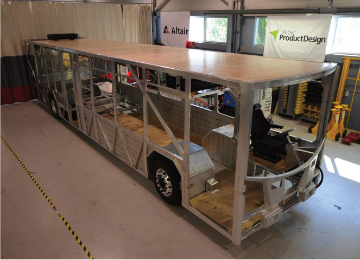
Sic Transit
Mike McLeod
CAD/CAM/CAE Fluid Power Automotive Altair alternative energy design hydraulic Innovation SustainableAltair Engineering's software and design talents craft the next generation of fuel efficient transit buses.

Designed by Altair subsidiary, Altair ProductDesign, the BUSolutions prototype aims to prove that a hydraulic hybrid transit bus can boost fuel efficiency at a fraction of the cost of electric.
Overall, Americans took more than 10.3 billion trips in 2007 and ridership continues to expand at more than two times population growth. The increased demand has left bus manufacturers with a 1- to 2-year order backlog, forcing many transit authorities to push in-service buses past their typical 12-year lifespan. To meet operating budgets, transit authorities receive roughly US$26 billion annually from government sources.
But, for all their utility, buses get notoriously bad fuel mileage. According to fl eet records, even best-in-class conventional buses get approximately 3.5 mpg on a 8.3L diesel engine. Of course, it’s the strain put on the engine from constant stop-and-go drive cycles that limit the effi ciency of any conventional bus’ powerplant.
To improve effi ciency, bus manufacturers have implemented different techniques, which revolve around supplementing the core diesel engine with an assisting power source to help get the 27,500 lbs. bus to speed, without having to burn a fossil fuel. Electric motors paired with rechargeable batteries and regenerative breaking mechanisms have been the most common option to date. Electric hybrids, however, have one critical limitation, says Mike Heskitt, executive VP of engineering at Altair ProductDesign, a subsidiary of CAE software company, Altair Engineering.
“Electric hybrids cost a lot more to buy and require at least one expensive battery replacement in the 12 year life of the bus, so you essentially eliminate the savings from fuel effi ciency,” he says. “If it’s a design that costs more to run, then you really have to ask yourself if that is a sustainable business model.”
Since 2005, Altair ProductDesign, in partnership with Michigan non-profi t technology association AutomationAlley and funding from the U.S. Federal Transit Authority and the Department of Transportation, have been developing the BUSolutions program, an initiative that aims to design, manufacture and commercialize an advanced bus platform with twice the fuel economy of standard diesel buses but costs 30 percent less than electric hybrids.
“We knew that if we applied our automotive technologies to the transit industry, we could make some signifi cant gains in making the a bus that was lighter, easier to maintain and lowered cost of ownership,” explains Heskitt. “At fi rst, we were looking to demonstrate our processes on this segment. But, eventually, we decided to build a physical prototype to demonstrate the benefi ts.”

Altair Engineering's CAE software Opti-Struct optimized the design of the BUSolutions prototype's all aluminum chasis
“What we are able to do is package all the bus’ systems where they naturally want to be and then use the topology optimization in Opti-Struct that let’s you layout the structural architecture in the best load pass for your package,” he says. “What you end up with is a minimum mass architecture.”
In addition to the optimized structural design, another factor in the BUSolution prototype’s favour is its reduced curb weight. At 25,800 pounds, it’s approximately one tonne lighter than a convention bus due, in large part, to its 100 percent aluminium chassis. Not only does the material save considerable weight, but its properties also allowed the engineers explore unconventional design possibilities, Heskitt says.
“The chassis uses aluminium extrusions with wall thicknesses all tailored to provide lightweight optimized design,” he says. “With extrusion, you can also design in a lot of integrated, multi-function features that ultimately makes your assembly less complex later.”
The final component to achieving the prototype’s goals, says Heskitt, is the replacement of electric with a hydraulic assisted system developed by Parker Hannifin. With these systems, a high-pressure hydraulic accumulator captures approximately 70 percent of the breaking energy. When the bus accelerates again, the stored pressure is channelled through a hydraulic motor/pump that provides forward momentum and allows the diesel engine operate at its efficiency sweet spot.
“If you look at the hydraulic technologies, these fundamental components have been in the construction industry for years,” he says. “The cost increase is minimal and there really isn’t a big maintenance cost; you have to replace the bladders in the high pressure tanks, but they’re only $200 each.”
In addition to the lower cost of ownership compared to electric hybrids, Heskitt says the higher purchase cost of a hydraulic hybrid bus is projected at US$50,000 more than standard diesel bus ($300,000) as opposed to $500,000 or $480,000 for parallel and series electric hybrids, respectively.
At present, the BUSolution program has completed its first demonstrator prototype which will begin fuel economy testing in the spring in preparation for the bus’ official unveiling around the summer of 2011.
www.altairproductdesign.com
